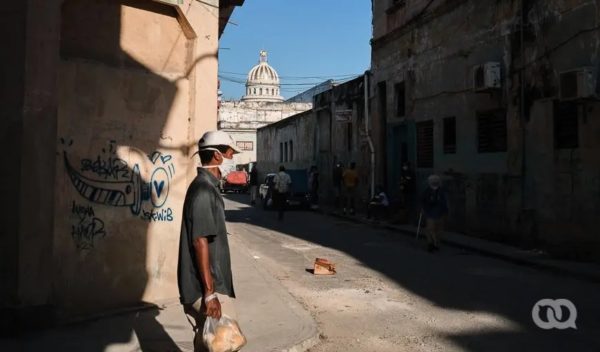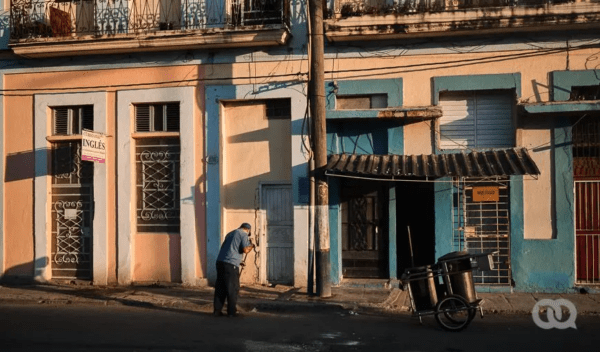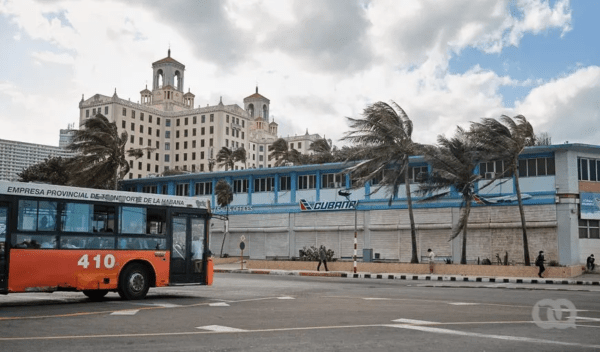US-Cuba Humanitarian Corridor?

By Yerys M. Garcia (El Toque)
HAVANA TIMES – Over 900 people signed the petition by Feministas Cubanas on Change.org, requesting the Cuban government can open up a corridor of humanitarian flights from the US. Basic essentials, such as medicine and personal hygiene items, would enter the island via this corridor, without Customs restrictions.
Addressed to president Miguel Diaz-Canel, the Ministry of Foreign Relations, the Ministry of Interior and the Council of State and Ministers, the petition asks for mechanisms to be put into place so that Cubans living abroad can travel to the island and deliver these products, as long as they can provide proof of their COVID-19 vaccinations beforehand.
The text mentions the vaccination rate in the US, where “48.4% of the adult population has been vaccinated against the virus, and 60.5% have received at least one dose of the vaccines available in this country,” according to statements from the US Centers for Disease Control and Prevention (CDC).
It also announces that it is very easy to confirm that US residents wanting to enter Cuba with necessary resources have been fully vaccinated against COVID-19, as they have a card issued by this very center.
“Cuba is facing a serious health crisis right now, with shortages of medicines, food and personal hygiene items, caused by the country’s deteriorating economic situation and the COVID-19 pandemic,” the petition explains at the beginning, recognizing that “unilateral sanctions weigh heavily upon the country” and that “measures implemented by the Cuban government” restrict deliveries of these items.
Since February 6th, the Cuban government has cut down on certain flight connections and has canceled others, due to the declining health situation in the country. According to the Cuban Airports and Airport Services Company (ECASA) Facebook page, American Airlines, JetBlue, Southwest and charter flights will continue to fly from the US, on a weekly basis.
On the other hand, financial restrictions established by the embargo, as well as the ban on remittances being sent via different platforms (especially via Western Union), have directly affected the way Cubans living abroad can contribute.
Given this situation, individuals and organizations are looking for safe ways to send their aid to Cubans living on the island.

Humanitarian corridors, humanitarian flights or safe air travel corridors
Not every crisis situation justifies opening up a humanitarian corridor. On December 14, 1990, the UN General Assembly passed Resolution 45/100 that stipulated, for the first time, the need to establish this kind of safe route.
This resolution defines corridors as a means to facilitate the circulation of humanitarian convoys, victims of armed conflicts and humanitarian personnel. Transfers (of people or aid) normally take place from, or to, a region of armed conflict.
According to International Humanitarian Law and its implementation, such are established mostly in the system of peacekeeping missions and refugee protection programs by the UN and other international bodies. Depending on their purpose, safe areas can be defined as: providing humanitarian aid, evacuating endangered persons; and to encourage the repatriation of refugees and displaced persons. Humanitarian corridors can be land, sea or river or air routes.
Secondly, agreements between all parties involved are the key to these demilitarized areas. The Cuban government would have to enter in agreement with some US counterpart to establish “every party’s obligations, the principle of national sovereignty, the territorial integrity of the State in question” and respect for the so-called “Guiding Principles on the Right to Humanitarian Assistance“, which were written up at the International Institute of Humanitarian Law in San Remo, in 1992.
The five restrictions allude to:
- Time: humanitarian corridors are established during an emergency period, during which you have the right to travel and provide aid for as long as needed. As a result, if a corridor of humanitarian flights were established to bring medicine into Cuba, this would be limited to a fixed duration of time outlined between both parties.
- Space: the most direct route possible to the destination should be established. This means that if a corridor of humanitarian flights is established, medicines would leave from a certain place, and arrive at a certain place. Yet, the US government has banned charter flights from the US from reaching Cuban provinces, since March 10, 2020. In this case, mechanisms would have to be established and monitored so that aid can reach other provinces in Cuba, once they arrive at Jose Marti International Airport, in Havana.
- Objects: according to the San Remo document, only care items, medicines, emergency medical/surgical materials and food should be transported. In this case, people responsible for bringing aid are normally considered “humanitarian personnel”, and they are duly trained and focused on delivering and supervising aid. They should not be citizens living in one country, who are visiting citizens living in another.
- Practice: humanitarian corridors should not threaten peace, order or State security, in the places they are established.
- Ethical restrictions imply a respect for impartiality, and the obligation to prevent assistance from being diverted. In regard to these last two principles, the State receiving assistance will have to recognize a state of crisis and allow international organizations and humanitarian personnel to verify the mechanisms established to manage this assistance and that they comply with the agreement.
On the other hand, humanitarian flights and repatriation are normally used to transport passengers who have been left stranded in other countries, who require emergency medical treatment, or to take refugees away from areas of armed conflict, or to transport humanitarian assistance.
Generally-speaking, assistance is delivered via humanitarian personnel, not citizens who are interested in offering help. Their services should be free, as paying for this assistance goes against the humanitarian essence.
Furthermore, respective States, diplomatic missions, embassies, and aeronautical authorities involved must be responsible for organizing this assistance and covering costs. Once again, this depends on the agreement outlined between involved parties and under the San Remo’s five guiding principles.
Finally, safe air corridors have been applied in many countries, especially in the European Union, to ensure tourist travel between two countries with a similar Rt rate.
They normally go through different phases, depending on the health situation in the countries that decide to open up an air corridor. These phases range from more limited movement, to slowly lifting border controls, as the pandemic situation in both places improves.
Every country can outline its own methodology to create a corridor, but they normally have to receive authorization from international health organizations, that confirm or verify the States’ information about the pandemic and its impact.
Citizen-led assistance

This isn’t the first time that civil society groups or activists have created a petition for humanitarian aid to Cuba. One of the most popular was the letter signed by professor Carlos Lazo, which gained over 15,000 signatures, to the US president at the time, Donald Trump, asking the US to lift sanctions against Cuba during the pandemic. Months later, he wrote an open letter to Joe Biden with the same objective, that gained over 20,000 signatures.
Some of the most repetitive humanitarian petitions on platforms such as Change.org, and which involve the Cuban and US governments, have to do with opening up the US Embassy in Havana again so it offers all services, visa applications etc.; restoring the Cuban Family Reunification Parole Program) which was suspended in 2017; the elimination of strict Cuban Customs regulations; and the chance to send unlimited remittances back to Cuba.
Recent petitions for sending medicines to Cuba are now joining this list, and they involve three key routes: direct deliveries via courier services, raising money for buying sanitary materials via international organizations and money donations and resources for Cuban NGOs or NGOs based in Cuba.
The first route is mainly for organized citizens who use their own means to buy medicines and send them using different delivery platforms.
However, this tends to be the most expensive way, as prices depend on the weight of the delivery, as well as the expense of buying medicines. So, promoters are asking that charter and commercial flights begin to fly to Cuba more frequently, and for Customs restrictions to be lifted, so they can deliver this aid in person.
In this case, ensuring transparency of the delivery of resources will be a challenge, as aid directed to individuals or groups of people will make it difficult to register.
Organizers of these initiatives normally make appeals on social media so that networks can be formed in different countries, thereby minimizing delivery and purchase costs.
One of the more popular petitions has been the one organized by Reynaldo Lastre and Eilyn Lombard, which was shared on Facebook by the academic Mabel Cuesta. According to the organizers, they were able to raise “almost 3000 USD and infinite kilos of medicines” in less than 24 hours, Cuesta posted on her personal profile.
In a more recent post, Cuesta explained that half of the load was currently in Havana, according to the tracking service used by the delivery agency, and the rest will arrive at Varadero and Santa Clara Airports, coming from Canada.
She also posted on her page that they have received “a huge donation of medicines: antibiotics, surgical supplies, vitamins, gloves, digestive medicines, Omega, everything…”, and now they are collecting money via PayPay to send this as a package to Cuba.
The second route is used by international organizations and cooperation agencies, to contribute towards the COVID-19 vaccination process. Normally, big anti-US embargo campaigns are articulated, that seek to gain individual donors and organizations, so that once they’ve raised their target, this money can then be used to buy resources.
Cuba is using this mechanism to ask for help to buy syringes, needles and masks. The Canadian-Cuban Friendship Association and its network of members had managed to buy and send a container with 1,920,000 syringes by April 12th, and they are preparing the second one.

From Europe, the SODEPAZ organization has promised to collaborate in raising funds to buy 10 million syringes with the slogan “Blockades kill, your solidarity gives life”, and UN agencies such as UNICEF and PAHO have also delivered kits with supplies for COVID-19 health emergencies.
Puentes de Amor, project by professor Carlos Lazo, NEMO (Cuba Anti-Embargo Movement) and Codepink: Women for Peace have also launched a campaign to raise funds to buy syringes.
According to the organizers, they have a 100,000 USD target so they can send 3 million syringes to Cuba. Lazo himself said that “the US Department of the Treasury has granted a licence so that funds can be raised to buy syringes for Cuba.”
In these cases, donations would reach health authorities, who would then be responsible for distributing these resources to hospitals or care units and ensure they are being used ethically.
The third route to send medicines to Cuba consists of getting in touch with different non-governmental organizations (NGOs) that are working in Cuba. People, groups and organizations that get in touch with NGOs to deliver these resources to them.
The NGOs would then be responsible for distributing this aid and applying accountability mechanisms to donors. Caritas and the Dr. Martin Luther King Memorial Center are two of the NGOs that are normally in charge of collecting and distributing donations: the latter mostly coming from Pastors for Peace caravans.






Give The Cuban People all They Need to live a Healthy Simple life, Let Cubans Create a life that they understand Who are the ones that really provided for their Health needs& Food, Cubans Create their New Education system of No one political system. The Cuban Regime Will to be Cut Off from all Foreign Money That is the Blood line of their survival That Hold all Controls over the Cuba youth Labour & the Future of the Regimes Youth of todays & future Recruits. Cubans Can,t Eat Foreign Dollars & Their Regime uses the Tourist $ To Control the Herd that Graze the Island to Survive. I Support the embargo against Foreign$$ in the Banks of Cuba.
I support the embargo and I vote. Cuba has persecuted the LGBT for years and under Diaz Canel, things are getting worse. Cuba has arrested me at pride parades and banned marriages and adoption for LGBT people. Cuba is following Russia and Iran for culture. We should not support this hateful regime.